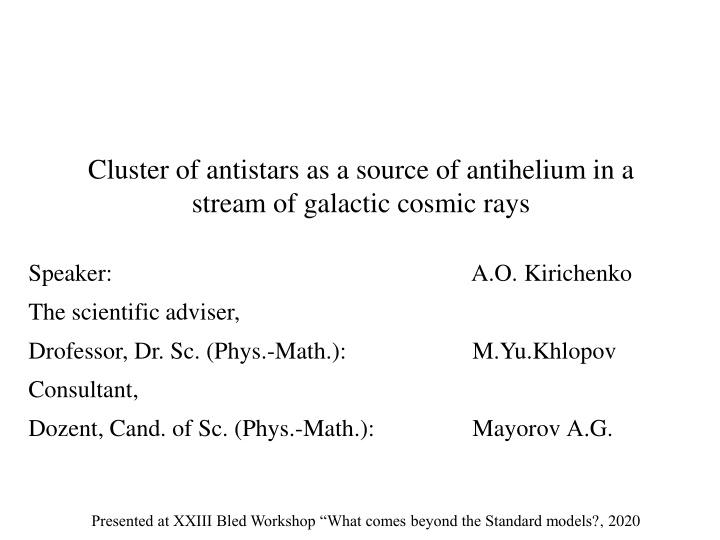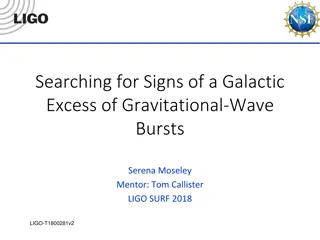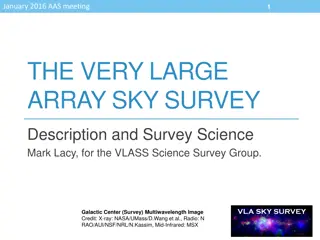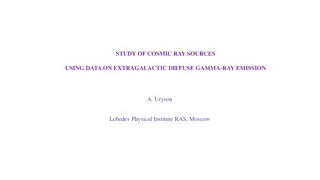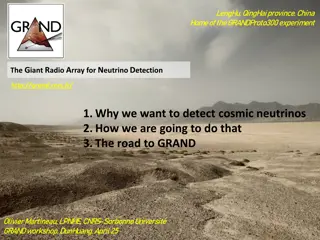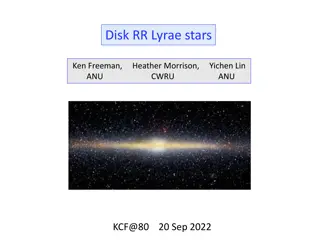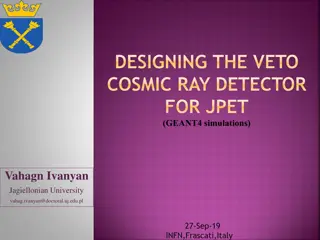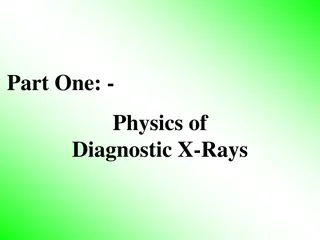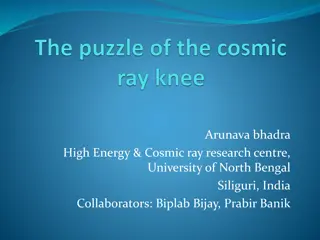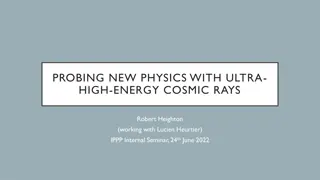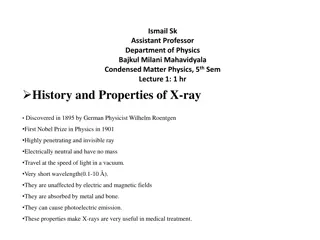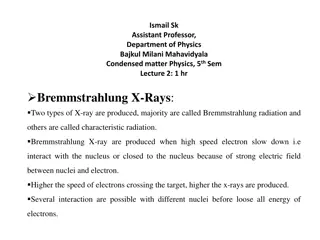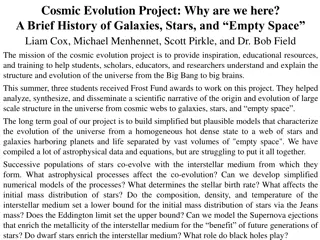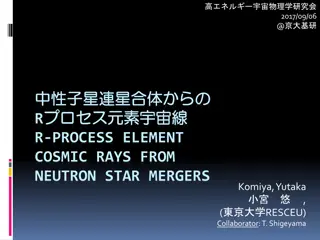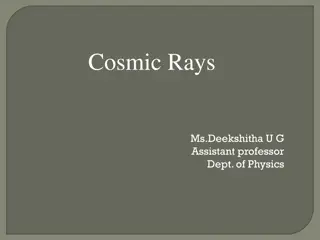Antimatter in Galactic Cosmic Rays: Source from Globular Cluster M4
The study delves into the potential source of antihelium-4 in galactic cosmic rays, focusing on the M4 globular cluster presumed to be composed of antistars. Antimatter's nature in the universe, baryosynthesis conditions, and mechanisms for antihelium-4 injection are explored. The intriguing concept of primordial antimatter and the formation of regions with antimatter excess in an inhomogeneous baryosynthesis scenario are also discussed.
Download Presentation

Please find below an Image/Link to download the presentation.
The content on the website is provided AS IS for your information and personal use only. It may not be sold, licensed, or shared on other websites without obtaining consent from the author.If you encounter any issues during the download, it is possible that the publisher has removed the file from their server.
You are allowed to download the files provided on this website for personal or commercial use, subject to the condition that they are used lawfully. All files are the property of their respective owners.
The content on the website is provided AS IS for your information and personal use only. It may not be sold, licensed, or shared on other websites without obtaining consent from the author.
E N D
Presentation Transcript
Cluster of antistars as a source of antihelium in a stream of galactic cosmic rays Speaker: The scientific adviser, Drofessor, Dr. Sc. (Phys.-Math.): M.Yu.Khlopov Consultant, Dozent, Cand. of Sc. (Phys.-Math.): A.O. Kirichenko Mayorov .G. Presented at XXIII Bled Workshop What comes beyond the Standard models?, 2020
Introduction Possible nature of antimatter in the universe: 1.Primordial antimatter. 2. Secondary antimatter (from cosmic rays interaction with matter). 3.Antimatter from exotic sources.
Primordial antimatter(1) The baryonic asymmetry of the Universe - is the observed predominance of matter over antimatter in the visible part of the Universe. A. D. Sakharov and V.A. Kuzmin formulated the necessary conditions for bariosynthesis: 1. Asymmetry between particles and antiparticles as a violation of charge C- and combined CP-symmetry. 2. Violation of the law of conservation of baryon charge in the early stages of the formation of the Universe. 3. Violation of local thermodynamic equilibrium in the early stages of the formation of the Universe. If baryosynthesis is nonhomogeneous, it may lead to antibaryon excess in some regions and this primordial antimatter is interesting for this work, because the object hypothetically consisting of primordial antimatter could be preserved in the halo of our Galaxy.
Primary antimatter(2) Therefore, in the Universe, not only regions with an excess of matter can be formed, but also regions with an excess of antimatter can be formed too in the case of inhomogeneous baryosynthesis. Globular clusters of antistars could form during the formation of the Galaxy and remain in its halo by now. The effect of the existence of a globular cluster of antistars can be the registration of antinuclei or the creation of the limit on their flux in the BESS, AMS-02, PAMELA experiments.
Globular clusters A globular star cluster is a group of stars which forms a cluster of a spherical shape, rotated around the center of the galaxy. 104 106 104 106 Number of stars Mass (in Solar mass) Age 10 15 Myr Characteristic diameters 20 60pc Illustration of our galaxy with detected globular clusters distributed around the center, the position of the Sun is indicated by a cross According to the catalog of galactic globular clusters http://gclusters.altervista.org/
Formulation of the problem The work considers a typical globular cluster, presumably consisting of antistars - the M4 cluster (age about 12 billion years, distance from the Sun 1.72 kpc, number of stars ~ 8 104[1]). Suppose that M4 is the source of antihelium-4 in galactic cosmic rays. Three possible injection mechanisms: 1. The stationary flow of matter from the surface of antistars(~ eV) 2. Flare antistars(~GeV) 3. AntiSupernova Explosions (~1015eV) [1] Douglas C. Heggie, Monte Carlo simulations of star clusters V. The globular cluster M4 (2008).
Secondary antimatter Secondary antimatter in the galaxy is formed as a result of the collision of the high-energy nuclear component of cosmic rays with interstellar gas. Studying the processes of birth of antinuclei on accelerators made it possible to determine the cross section of these processes. Figure [2] shows the calculated spectrum for secondary antiparticles 7 [2] Ilias Cholis, Tim Linden, Dan Hooper Anti-Deuterons and Anti-Helium Nuclei from Annihilating Dark Matter (2020)
Calculation of the injection of antistellar wind Globular clusters are massive objects in the galaxy. For further work, it is necessary to understand whether antimatter leaves the limits of the cluster. We calculate the second cosmic velocity: 2?? ?=15 m/s ?2= Where M and R are the mass and radius of the cluster, respectively. The stellar wind velocity is calculated according to the article [4]: ????? 700 m/s Stellar wind antimatter actively leaves the cluster starting from the lowest energies. 8 [4] C. P. Johnstone, M. G del Stellar winds on the main-sequence (2015)
High energy - supernova explosions(1) The result of numerical simulation of the evolution of the stellar population of the globular cluster M4 [1] Neutron stars are formed as a result of a supernova explosion. Their number makes it possible to obtain an estimate of the energy density of antiparticles in cosmic rays. [1] Douglas C. Heggie, Mirek Giersz Monte Carlo simulations of star clusters V. The globular cluster M4, (2008)
High energy - supernova explosions(1) Using the data from [1], and taking into account the analysis of the previous graph, we calculate the energy density of antiparticles in cosmic rays from the M4 cluster: ???=??? ??????? (1) ? Nsn -the number of neutron stars in M4 t age of 4 Nsn -supernova explosion frequency Esn-energy from one supernova ????- the lifetime of cosmic rays in the Milky Way V - scope of distribution [1] Douglas C. Heggie, Monte Carlo simulations of star clusters V. The globular cluster M4 (2008)
High energy - supernova explosions(3) Using table data Nsn Esn tret t V Nsn 2 104 107 years 13 109years 3 103kpc 2 10 5 1051erg We get the energy density value: ???=10 4eV/??3 cosmic ray energy density of matter: ?=1 eV/??3 Antiproton energy density[5]: ? ?= 10 5-10 4eV/??3 11 [5] The PAMELA collaboration Ten Years of PAMELAin Space
Modeling the motion of particles in the magnetic field of the Galaxy It is necessary to simulate the motion of particles in the magnetic field of the Galaxy in order to estimate the minimum particle energy penetrating the Galaxy s disk. 1. Development of a program for modeling particle motion. 2. Checking the correct operation of the program. 3. Starting particles and solving the equation of motion. The task is divided into three subtasks: 12
Development of a program for modeling the motion of particles in the magnetic field of the Galaxy The function program was written based on the conclusions of [6]. The input parameters of the program are the coordinates in the Galaxy, and the output parameters are the components of the magnetic field in the Cartesian coordinate system. The components of the magnetic field in a cylindrical coordinate system with a reference point in the Galactic center: Where R0 = 5 kpc and z0 = 0.5pc are scale lengths, and parameter B1 is free in this article and is determined by calibration, for example, by a magnetic field near the solar system according to [7]. 13 [6] C. J. Nixon, T. O. Hands The origin of the structure of large scale magnetic fields in disc galaxies (2018) [7] M. Opher, F. Alouani Bibi A strong, highly-tilted interstellar magnetic field near the Solar System
Checking the correct operation of the program(1) Magnetic field topology in the projection RZ. R and Z- coordinates in a cylindrical coordinate system. Topology resulting from the program: Topology from the article[6]: Magnetic field topology in the projection RZ kpc ,kpc 14 [6] C. J. Nixon, T. O. Hands The origin of the structure of large scale magnetic fields in disc galaxies (2018)
Checking the correct operation of the program(2) Magnetic field topology in the projection z=0. x and y- Cartesian coordinates (Coordinate system with origin at the Galactic center). Topology resulting from the program: Topology from the article[6]: Magnetic field topology in the projection z=0 kpc 15 [6] C. J. Nixon, T. O. Hands The origin of the structure of large scale magnetic fields in disc galaxies (2018)
Conclusion In this work, we studied the possible role of the processes of formation of antimatter domains on the basis of the model consisting in the fact that the globular cluster of anti-stars evolves in a similar way as a globular star cluster, based on the symmetry of the properties of matter and antimatter. 1. We calculated the energy density of antiparticles in cosmic rays from the cluster of antistars 2. We checked the work of the program for modeling the motion of particles in the magnetic field of the Galaxy. Further work will be aimed at modeling the motion of particles in the magnetic field of the Galaxy to estimate the minimum energy that a particle penetrating into a galactic disk should have. And in the end, to obtain predictions of the expected flux of antinuclei. Results:
